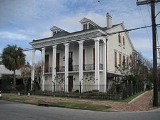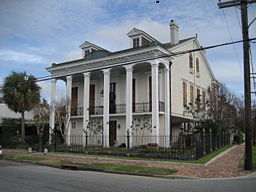
6th Ward of New Orleans
Encyclopedia
The 6th Ward or Sixth Ward is one of the seventeen Wards of New Orleans
, located in the Downtown
section of the city of New Orleans, Louisiana
.

. The boundary to down-river or "lower" side (to the north east in this case) is Esplanade Avenue
, across which is the 7th Ward
. The lower limit is Saint Philip Street, across which is the 5th Ward
. The back boundary is Bayou St. John
, the land across which is also part of the 5th Ward. This geographically small ward is just under 40 blocks from front to back, but only 4 blocks wide.
and the old New Orleans Mint
building, now a museum. Beyond a largely commercial section of Decatur Street which includes some of the city's better known music clubs and bars is the still largely residential section of the lower French Quarter
. Cabrini Park is a piece of public green space here in the city's oldest urban neighborhood. On the other side of Rampart Street, the 6th Ward includes the heart of the Treme
neighborhood, including Saint Augustine Church and the Backstreet Cultural Museum
. The Ward continues back along Esplanade Ridge, developed by the city's Creole
communities in the 19th century, including elegant old mansions along Esplanade, one of which was the residence of Edgar Degas
during the time he stayed with his relatives in the city. Just back from Broad St. is the former home of jazz musician Paul Mares
, where the New Orleans Rhythm Kings
rehearsed while they were in town. At the back of the Ward along the Bayou is the historic home of James Pitot
, second Mayor of New Orleans, now the Pitot House
museum.
Wards of New Orleans
The city of New Orleans, Louisiana is divided into 17 wards. Politically, the wards are used in voting in elections, subdivided into precincts. Under various previous city charters of the 19th century, aldermen and later city council members were elected by ward. The city has not had officials...
, located in the Downtown
Downtown New Orleans
In New Orleans, Louisiana, USA, "downtown" has historically referred to neighborhoods along the Mississippi River down-river from Canal Street, including the French Quarter, Treme, Faubourg Marigny, Bywater, the 9th Ward, and other neighborhoods...
section of the city of New Orleans, Louisiana
New Orleans, Louisiana
New Orleans is a major United States port and the largest city and metropolitan area in the state of Louisiana. The New Orleans metropolitan area has a population of 1,235,650 as of 2009, the 46th largest in the USA. The New Orleans – Metairie – Bogalusa combined statistical area has a population...
.

Boundaries
The 6th Ward is a long narrow ward stretching back from the Mississippi RiverMississippi River
The Mississippi River is the largest river system in North America. Flowing entirely in the United States, this river rises in western Minnesota and meanders slowly southwards for to the Mississippi River Delta at the Gulf of Mexico. With its many tributaries, the Mississippi's watershed drains...
. The boundary to down-river or "lower" side (to the north east in this case) is Esplanade Avenue
Esplanade Avenue, New Orleans
-History:Esplanade runs from the Mississippi River front to the intersection with Carrollton Avenue just past Bayou St. John, and the entrance to City Park. In the 19th century it was important as a portage route of trade between the Bayou which linked to Lake Pontchartrain and the River...
, across which is the 7th Ward
7th Ward of New Orleans
The 7th Ward is a section of New Orleans, Louisiana. It is geographically the second largest of the 17 Wards of New Orleans, after the 9th Ward.-Boundaries and geography:...
. The lower limit is Saint Philip Street, across which is the 5th Ward
5th Ward of New Orleans
The 5th Ward or Fifth Ward is a division of the city of New Orleans, Louisiana, one of the 17 Wards of New Orleans.-Boundaries:The roughly "L" shaped ward stretches through the city from the Mississippi River to Lake Pontchartrain. The lower boundary is St. Philip Street, across which is the 6th...
. The back boundary is Bayou St. John
Bayou St. John
Bayou St. John is a bayou within the city of New Orleans, Louisiana.The Bayou as a natural feature drained the swampy land of a good portion of what was to become New Orleans into Lake Pontchartrain...
, the land across which is also part of the 5th Ward. This geographically small ward is just under 40 blocks from front to back, but only 4 blocks wide.
Features and landmarks
At the Riverfront is the Governor Nicholls Street Wharf. Just back from the wharf is the lower terminus of the Riverfront Streetcar line. Continuing inland, beyond a flood wall is the French MarketFrench Market
The French Market is a market and series of commercial buildings in the French Quarter of New Orleans, Louisiana, USA.It stretches just inland from the Mississippi River in the section of the French Quarter downriver from Jackson Square, with the famous Café du Monde at the upriver end, down to the...
and the old New Orleans Mint
New Orleans Mint
The New Orleans Mint operated in New Orleans, Louisiana, as a branch mint of the United States Mint from 1838 to 1861 and from 1879 to 1909. During its years of operation, it produced over 427 million gold and silver coins of nearly every American denomination, with a total face value of over...
building, now a museum. Beyond a largely commercial section of Decatur Street which includes some of the city's better known music clubs and bars is the still largely residential section of the lower French Quarter
French Quarter
The French Quarter, also known as Vieux Carré, is the oldest neighborhood in the city of New Orleans. When New Orleans was founded in 1718 by Jean-Baptiste Le Moyne de Bienville, the city was originally centered on the French Quarter, or the Vieux Carré as it was known then...
. Cabrini Park is a piece of public green space here in the city's oldest urban neighborhood. On the other side of Rampart Street, the 6th Ward includes the heart of the Treme
Treme
Tremé is a neighborhood of the city of New Orleans. A subdistrict of the Mid-City District Area, its boundaries as defined by the City Planning Commission are Esplanade Avenue to the north, North Rampart Street to the east, St. Louis Street to the south and North Broad Street to the west...
neighborhood, including Saint Augustine Church and the Backstreet Cultural Museum
Backstreet Cultural Museum
The Backstreet Cultural Museum is a museum in New Orleans, Louisiana's Tremé neighborhood.The museum's collections include objects relating to the African American culture of New Orleans with a special emphasis on jazz funerals, Mardi Gras Indians, and second lines parades sponsored by Social Aid...
. The Ward continues back along Esplanade Ridge, developed by the city's Creole
Louisiana Creole people
Louisiana Creole people refers to those who are descended from the colonial settlers in Louisiana, especially those of French and Spanish descent. The term was first used during colonial times by the settlers to refer to those who were born in the colony, as opposed to those born in the Old World...
communities in the 19th century, including elegant old mansions along Esplanade, one of which was the residence of Edgar Degas
Edgar Degas
Edgar Degas[p] , born Hilaire-Germain-Edgar De Gas, was a French artist famous for his work in painting, sculpture, printmaking and drawing. He is regarded as one of the founders of Impressionism although he rejected the term, and preferred to be called a realist...
during the time he stayed with his relatives in the city. Just back from Broad St. is the former home of jazz musician Paul Mares
Paul Mares
Paul Mares , was an American early dixieland jazz cornet & trumpet player, and leader of the New Orleans Rhythm Kings.Mares was born in New Orleans. His father, Joseph E...
, where the New Orleans Rhythm Kings
New Orleans Rhythm Kings
The New Orleans Rhythm Kings were one of the most influential jazz bands of the early-to-mid 1920s. The band was a combination of New Orleans and Chicago musicians who helped shape Chicago Jazz and influenced many younger jazz musicians....
rehearsed while they were in town. At the back of the Ward along the Bayou is the historic home of James Pitot
James Pitot
James Pitot was the second Mayor of New Orleans.Born Jacques-François Pitot in Normandy and educated in Paris, Pitot's family was of the nobility of France, and fled that nation for the New World with the French Revolution. At first he settled in Philadelphia, where he became a USA citizen...
, second Mayor of New Orleans, now the Pitot House
Pitot House
The Pitot House is a historic landmark in New Orleans, and is listed on the National Register of Historic Places.The Pitot House is an 18th century Creole colonial plantation home located at 1440 Moss Street in New Orleans, Louisiana. The Pitot House is currently owned by the Louisiana Landmark...
museum.

